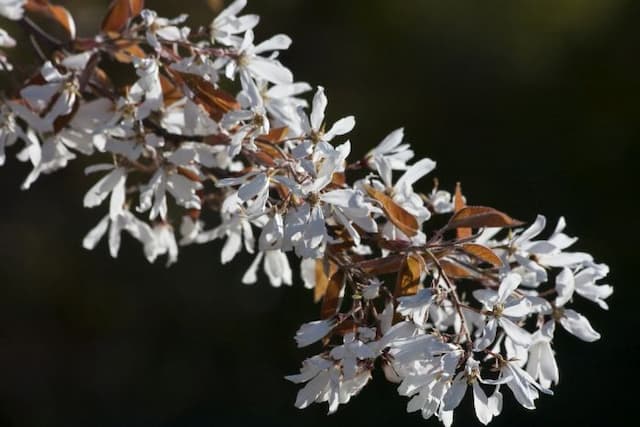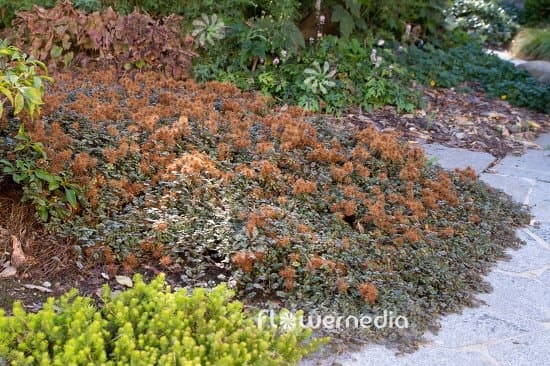Thunberg Spirea Spiraea thunbergii

ABOUT
The plant commonly known as Thunberg's meadowsweet or Thunberg spirea, is a deciduous shrub that showcases a graceful, fountain-like growth habit. Its wiry, slender stems are adorned with small, lance-shaped leaves that have a fresh, green color and may exhibit a slight yellow to reddish hue in fall before they drop. In early spring, the plant becomes a focal point in the landscape as it bursts into a profusion of small, white flowers. Each blossom is composed of five petals arranged in delicate, clustered groupings that cover the branches, creating a soft, fluffy appearance reminiscent of tiny clouds or cotton candy. After the blooming period, the oval leaves take over in visual prominence, giving the plant a fine-textured greenery that persists until autumn.
About this plant
 Names
NamesFamily
Rosaceae
Synonyms
Thunberg's Meadowsweet, Thunberg Spirea, Baby's Breath Spirea
Common names
Spiraea thunbergii Muehlenbeckia thunbergii, Spiraea lindleyana
 Toxicity
ToxicityTo humans
Thunberg's meadowsweet is generally considered non-toxic to humans. There is no widely recognized risk of poisoning from ingesting the plant, and no common symptoms of toxicity associated with it. Therefore, though it is not advisable to consume any plant material without proper knowledge, there are no specific consequences noted for ingesting Thunberg's meadowsweet.
To pets
Thunberg's meadowsweet is not commonly known to be toxic to pets either, including cats and dogs. Just like for humans, there is no significant risk of poisoning or any characteristic symptoms that arise from pets ingesting this plant. While it is generally advisable to prevent pets from eating non-food plants because of the potential for digestive upset, Thunberg's meadowsweet is not known for having any toxic effects if consumed.
 Characteristics
CharacteristicsLife cycle
Perennials
Foliage type
Deciduous
Color of leaves
Green
Flower color
White
Height
4-5 feet (1.2-1.5 meters)
Spread
4-5 feet (1.2-1.5 meters)
Plant type
Shrub
Hardiness zones
4
Native area
China Japan
Benefits
 General Benefits
General Benefits- Landscape beautification: Spiraea thunbergii, commonly known as Thunberg's meadowsweet, adds aesthetic appeal to gardens with its white, delicate flowers and arching branches.
- Erosion control: The plant’s root system can help prevent soil erosion, making it beneficial for slope stabilization and riverbank reinforcement.
- Habitat for wildlife: Thunberg's meadowsweet provides shelter and nesting sites for birds and beneficial insects.
- Seasonal interest: With its early spring blooms and sometimes colorful autumn foliage, Thunberg's meadowsweet offers visual interest throughout multiple seasons.
- Low maintenance: Thunberg's meadowsweet is known for being easy to care for, making it a great option for low-maintenance landscapes.
- Drought tolerance: Once established, Thunberg's meadowsweet can tolerate periods of drought, reducing the need for frequent watering.
- Pollinator support: The flowers of the Thunberg's meadowsweet are attractive to pollinators like bees, which are essential for the pollination of many other plants.
- Propagation and rejuvenation: Thunberg's meadowsweet is easily propagated through cuttings or division and can be pruned to rejuvenate its growth and shape.
- Border and hedge use: The dense growth habit of Thunberg’s meadowsweet allows it to be used effectively as a border plant or informal hedge.
- Cultural significance: In some regions, Thunberg's meadowsweet holds cultural significance and is included in traditional garden designs.
 Medical Properties
Medical PropertiesThis plant is not used for medical purposes.
 Air-purifying Qualities
Air-purifying QualitiesThis plant is not specifically known for air purifying qualities.
 Other Uses
Other Uses- Thunberg's meadowsweet can be used in landscape design as a ground cover plant due to its mat-forming nature and dense foliage.
- Use branches of Thunberg's meadowsweet for crafting wreaths and other floral decorations thanks to its delicate white flowers and flexible stems.
- The plant can be incorporated into bonsai art because of its small leaves and visually appealing branch structure.
- Thunberg's meadowsweet can serve as a natural fence or privacy screen when planted in rows or hedges.
- The fibrous roots of Thunberg's meadowsweet help with soil stabilization on slopes or areas prone to erosion.
- You can use the branches in aquariums to create a natural and decorative look while providing hiding spaces for fish.
- Pressed flowers from Thunberg's meadowsweet can be used in botanical art or to make natural greeting cards.
- Leaves from the Thunberg's meadowsweet provide a soft bedding material for small animals in terrariums or vivariums.
- When dried, the plant's flowers can be used in potpourris to add a light, spring-like fragrance to rooms.
- The blooms of Thunberg's meadowsweet can be used as a natural dye for textiles, producing soft, earthy tones.
Interesting Facts
 Feng Shui
Feng ShuiThe Thunberg spirea is not used in Feng Shui practice.
 Zodiac Sign Compitability
Zodiac Sign CompitabilityThe Thunberg spirea is not used in astrology practice.
 Plant Symbolism
Plant Symbolism- Purity: Spiraea thunbergii, commonly known as Meadowsweet, is often associated with purity due to its delicate white flowers and its clean, bright appearance in the landscape.
- Protection: In some cultures, Meadowsweet is believed to have protective qualities. It's sometimes planted around homes and gardens to keep away negative energies or spirits.
- Happiness and Joy: The cheerful blossoms of the Meadowsweet plant are symbolic of happiness and joy, making it a popular choice for celebrations and happy occasions.
- New Beginnings: The early blooming nature of Meadowsweet signifies new beginnings as it is one of the first plants to flower in the spring.
 Water
WaterThe most common name for Spiraea thunbergii is Thunberg spirea. To water Thunberg spirea, ensure the soil is kept consistently moist but well-drained, avoiding waterlogging. During the growing season, water this plant about once a week, providing approximately one to two gallons for each plant, depending on the size and the environmental conditions. In periods of drought, the frequency may need to be increased. Reduce watering in the fall leading up to winter when the plant is dormant.
 Light
LightThunberg spirea flourishes best in full sun to partial shade. The ideal spot would provide at least six hours of direct sunlight daily, although some afternoon shade can be beneficial in hotter climates. Avoid deep shade as it can lead to sparse foliage and fewer flowers.
 Temperature
TemperatureThunberg spirea can tolerate a range of temperatures but performs best in conditions between 60°F and 75°F. It can survive minimum temperatures to around -20°F, and it requires a cold dormancy period, so it's suited to USDA hardiness zones 4 through 8.
 Pruning
PruningPrune Thunberg spirea to maintain shape and encourage robust growth and flowering. The best time for pruning is immediately after the plant has finished blooming in late spring or early summer. Remove old, weak canes and trim back spent flowers to promote a second round of blooms. Pruning should be done annually to keep the plant looking tidy and healthy.
 Cleaning
CleaningAs needed
 Soil
SoilThunberg Spirea thrives in well-draining, loamy soil with a pH range of 6.0 to 7.0. A mix containing equal parts garden soil, peat moss, and perlite or sand is ideal, promoting good drainage and aeration.
 Repotting
RepottingThunberg Spirea, being a garden shrub, does not typically require repotting as it is not commonly grown in containers. Instead, it may need occasional transplanting to accommodate growth if grown in a garden setting.
 Humidity & Misting
Humidity & MistingThunberg Spirea prefers average outdoor humidity levels and is quite adaptable, not requiring specific humidity conditions for growth.
 Suitable locations
Suitable locationsIndoor
Keep Thunberg Spirea in a bright spot with room to grow.
Outdoor
Plant Thunberg Spirea in sun to partial shade, well-drained soil.
Hardiness zone
4-8 USDA
 Life cycle
Life cycleThunberg Spiraea, commonly known as Thunberg's meadowsweet, begins its life cycle when seeds germinate in late winter to early spring, often requiring a period of cold stratification to break dormancy. Upon germination, the young plant enters a vegetative stage, growing stems, leaves, and a root system to establish itself. During spring, Thunberg's meadowsweet transitions to a reproductive stage, producing clusters of small, white flowers which attract pollinators for sexual reproduction. After pollination, the flowers develop into capsules containing numerous seeds that mature by late summer. As fall approaches, the plant enters a period of dormancy, with leaves turning yellow and dropping off as the plant conserves energy. Thunberg's meadowsweet can live for many years, undergoing annual cycles of growth, blooming, and dormancy.
 Propogation
PropogationPropogation time
Early spring
The most popular method of propagation for Bridalwreath Spirea (Spiraea thunbergii) is through softwood cuttings. This technique is usually done in late spring or early summer when the plant’s growth is new and green but has not yet hardened. Cuttings should be about 4 to 6 inches (10 to 15 centimeters) long and have several leaves. To encourage root growth, the bottom inch of the cutting is commonly dipped in rooting hormone powder. Afterward, the cuttings should be planted in a moist, well-draining potting mix and kept in a bright, indirect light environment with high humidity. Rooting can take anywhere from 3 to 4 weeks, after which the new plants can be transplanted into individual pots or directly into the garden.









